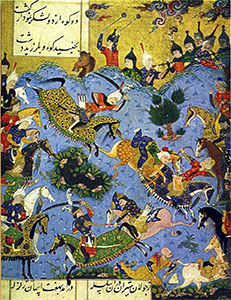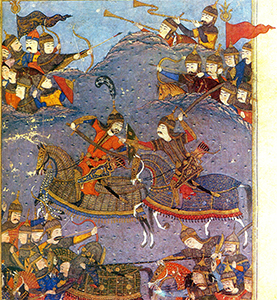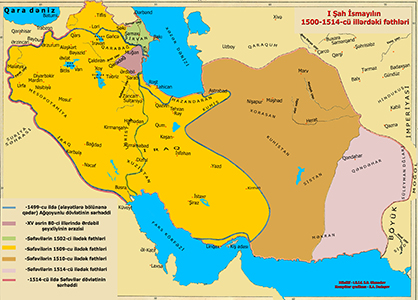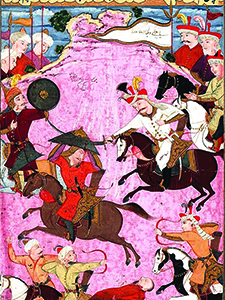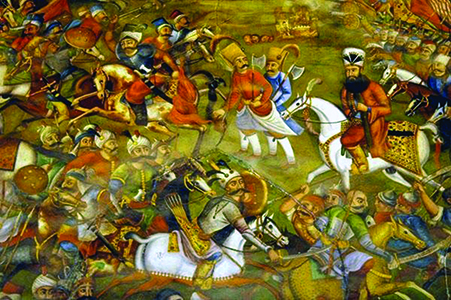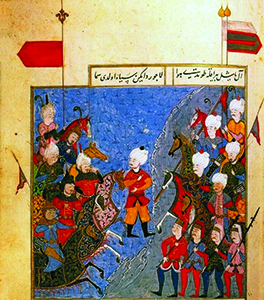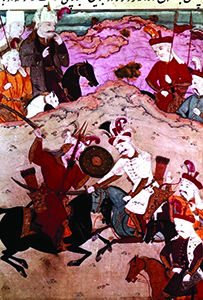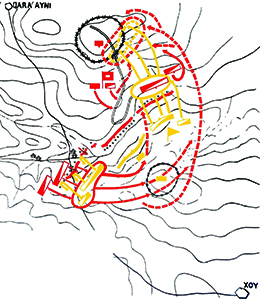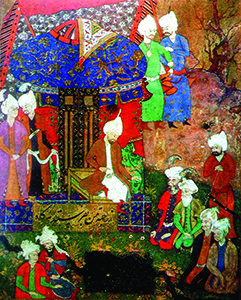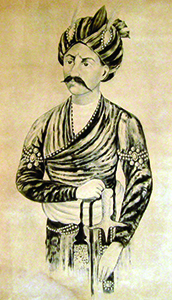The Battle of Jabani and the subjugation of the Shirvanshah state
Ismail, who started marching in 1499, moved along the route Lahijan - Tarom - Khalkhal - Erjuvan - Chukursad - Erzincan and gathered an army of seven thousand warriors. From here the Qizilbash quickly marched to Shirvan.
The vanguard group of the army had to cross the River Kura at the place called Qoyun olumu (the Death of Qoyun), but did not consider it possible to cross the river. Ismail was the first to swim to the opposite shore on horseback, and then led the whole army. Shirvanshah Farrukh Yasar left Shamakhi and went to Gabala fortress. When Ismail entered Shamakhi, the entire population had already left the city. Upon learning of the capture of Shamakhi, Farrukh Yasar decided to retreat to the Gulustan fortress, but he could not reach the castle.
At the end of 1500, a battle took place between Ismayil and Shirvanshah Farrukh Yasar in a place called Jabani near the Gulustan fortress. Ismail destroyed the troops of Farrukh Yasar, who had 20,000 cavalry and 6,000 infantry at the head of 7,000 cavalry.Shirvanshah Farrukh Yasar was killed. Surviving parts of Shirvan troops retreated to Gulustan fortress.
Ismail stayed on the battlefield for three days and then returned to Shamakhi. In order to spend the winter of 1500-1501, the qizilbash came to the city of Mahmudabad, and Ismail sent part of the army to capture Baku. Seeing the failure of his commanders' attempts to capture the fortress, Ismail moved to Baku with his main forces in the early spring of 1501. The ditch around the fortress, where the city was besieged, was filled, and one of the towers was destroyed by an underground sewer. The city was captured, the treasury of the Shirvanshah state was seized.
Authors of the later period, who were hostile to the Safavids, wrote that Ismail allegedly captured Baku and burned the bones of the Shirvanshahs. However, the Soviet researcher I. Petrushevsky shows that in 1947, when the graves in the Shirvanshahs' palace were opened, it was determined that they were untouched.
The surviving parts of Shirvanshah's troops were retreated to Gulustan fortress. After capturing Baku, Ismail went to capture the Gulustan fortress. However, he soon abandoned the siege of Gulustan and explained it to his emirs by receiving instructions from the imam in a dream. According to the legend, Ismail gathered the amirs of Qizilbash and asked them: "What do you want, the throne of Azerbaijan or the fortress of Gulustan?" They unanimously stated their preference for Azerbaijan.
The Battle of Jabani demonstrated that 14-year-old Ismail was an innately military talented commander, capable of leading his warriors to victory with his personal courage.
The capture of a strategic fortress such as Baku, which had a three-line defense system, demonstrated Ismail's mastery of the siege of the time (complete siege of the fortress, filling the trench during the battle, demolishing one of the towers with an underground sewer).
Battles of Sharur and Almagulagi
When the Safavid Army marched to Shirvan, there were two states in the south.. Power struggles between the Agqoyunlu princes, which began in the late 15th century, eventually led to the disintegration of the state in 1500, and the official division of power between Alvand Mirza and Sultan Murad.
When Gizilbash's army started moving south from Gulustan fortress, Ismail received the news that Agqoyunlu ruler Alvand Mirza was attacking with 30,000 troops from Tabriz, captured Ardabil, Karabakh and Garadagh. Ismail gathered all his forces, crossed the Kura and advanced towards Nakhchivan, where Alvand's troops were concentrated. His leading units defeated Alvand's front units.
Trying to gain time, Alvand sent a letter to Ismayil, promising to recognize him as the ruler of Shirvan. Most of emirs and even the prime minister, who was overwhelmed by the chaos in the Agqoyunlu state, sided with Ismail. Nevertheless, Alvand decided to fight. The decisive battle took place in the summer of 1501 on the plain of Sharur. Choosing a three-winged battle line, Ismail stood at the center of his 17,000-strong army. Alvand lined up his 30,000-strong army and placed camels chained behind each other to ensure the stability of the position. Ismail won the battle and Alvand fled to Erzincan. The Redheads took great booty.
After the victory, Ismail entered Tabriz without any obstacles. The cities and emirs of Azerbaijan recognized the rule of Ismail. Ismail declared the establishment of the Safavid state in Tabriz and declared himself the king of this state. Shiism was declared the state religion. Alvand's attempts to gather new forces and return to Azerbaijan were prevented.
By winning the battles of Jabani and Sharur, Ismail united the historical lands of Azerbaijan within a single state.
Sultan Murad, the ruler of the other part of the Aghgoyunlu state, which covered Iraq and Persia, was rapidly losing influence in the territories under his control. Shah Ismail I reduced taxes and was able to ensure stability by preventing lawlessness in the territories ruled by him. Most of the Agqoyunlu commanders sided with Ismail.
Ismail sent a letter to Murad, reminding him of the kinship between them and urging him to obey, but Murad refused. Although he gathered 70,000 troops, he did not dare to attack. The decisive battle between them took place in June 1503 in a place called Almagulagi. Ismail won, Murad's state was abolished, and the Persian province and Iraq-Ajam were conquered.
The victories of Shah Ismail I in 1503-1509
Shah Ismail I began to introduce a new currency in the Safavid state, regulated taxes. He tried to prevent the injustice of government officials, and created conditions for the development of trade. At the same time, Shah Ismail I was preparing for new campaigns.
The rivals of the Qizilbash Army were numerous local rulers of the Near and Middle East. Although they were superior in number, they were morally weaker than the Qizilbash Army. The arrival of Ismayil, who had established a just government and a benevolent policy in the occupied territories, was greeted with joy by peasants, artisans, merchants and petty feudal lords. Shah Ismail, who carried out very fast operations, defeated in small batches without allowing the opposing provincial leaders to unite.
In 1503-1504, Shah Ismail I managed to capture such powerful cities as Shiraz, Isfahan, Kashan, Gum, Firuzkuh, Yazd. Large provinces such as Persia, Khuzistan, Gilan, Mazandaran, and Kerman joined his state. In 1506, Ismail subjugated Diyarbakir. In the west, the border of the Safavid state reached the borders of the Ottoman state.
In 1507, Kurdistan was captured, and in 1508, Iraq-Arabia. The reign of Shah Ismail I was established in Baghdad, one of the largest centers of the Islamic world. In 1510, the Qizilbash Army had already reached the banks of the Amu Darya River.
The eastern borders of the Safavid state extended from Central Asia to the borders of the Sheybani state.
Battle of Merv and the capture of Khorasan
The Uzbek Mohammad Sheybani Khan laid the groundwork for the future conflict with a letter sent to Shah Ismail during the capture of Isfahan, which was of strategic importance to the Safavid state, "I will come to the borders of Iran and Azerbaijan, and after capturing it I will go to Iraq-Arab and Hijaz." In 1507, the ruler of the Sheybani state, Muhammad Sheybani Khan, captured Mavarannahr (Transoxania) and overthrew Babur, the ruler of Timurid. Babur was an ally of the Safavids in the region. Muhammad Sheybani Khan kept in touch with the Ottoman state and did not hide his plans to set the Safavid state between two fires.
The Sheybani and Safavids sought to establish themselves in the strategically important province of Khorasan. In 1510, Muhammad Sheybani Khan captured Herat, and Shah Ismail I captured the cities of Mashhad and Tus. The rapid movement of the Qizilbash army was unexpected for Mohammad Sheybani Khan: until the Sheybani reached the city of Merv, the Safavids fortified themselves in Sarakhs and besieged the city of Merv.
In a heavy battle near the village of Tahirabad, the front detachments of the Qizilbash army repulsed the Sheybanis and did not allow them to leave the city.
While standing in front of the walls of Merv, the Qizilbash commanders offered to attack the city, but Shah Ismail I did not accept these offers. Realizing that great losses were inevitable during the attack on the city, the Shah tried to minimize the losses of the army. Within a week, the shah tried to remove the Sheybanis from the Merv fortress by various tricks, but managed to disperse the separate groups. Finally, he applied the trick of "false retreat."
On December 2, 1510, Muhammad Sheybani Khan, who had been deceived and left the fortress of Merv, divided his army into three parts and began to pursue the Qizilbash. But the central part of khan's army of 5,000 together with the ruler was besieged by the shah's army of 17,000.
In the battle, Muhammad Sheybani Khan was killed and his army was routed. Shah Ismail I, who attacked quickly, captured the fortress of Merv.
As a result of the Battle of Merv on December 2, 1510, Khorasan was annexed to the Safavid state. Babur, an ally of the Qizilbash, was brought to power again in Mavarannahr. In this battle, Shah Ismail I proved to be a commander who skillfully managed large troops and carried out strategic operations.
The king prevented meaningless losses by not sending troops to a stronghold like Merv Fortress. Ismail, who was able to persuade him to retreat in the intense psychological struggle with the enemy, skillfully carried out the trick of "false retreat".
As a result of Shah Ismail I's overthrow of Sheybani ruler, the descendant of Genghis Khan at the expense of his command, everyone began to compare the young Shah with Alexander the Great.
BEGINNING OF SAFAVID-OTTOMAN WARS
Safavid-Ottoman relations were founded in 1504. Shah Ismail I, who captured the territories near the Ottoman borders, sent gifts and letters to Sultan Bayezid II, and in return received a congratulatory letter and gifts on the occasion of his victories.
Shah Ismail I was concerned about fact that Agqoyunlu Sultan Murad was a relative and ally of Diyarbakir ruler Zulqader Alauddovle. In order to prevent threats to trade routes that was stretching far long to the west, he promptly crossed the lands of Ottomans and entered Albistan. Having defeated three troops of Allauddovle, the shah seized Kharput and Diyarbakr in 1507-1508. As he had to cross over the lands of Ottomans, the shah sent a letter of apology: “My father Sultan, I do not claim on his lands”. In this regard the incident was closed.
As a result of internal wars, clashes among princes, and as a consequence of ravage of the areas and increase in taxation caused the uprisings that had occurred in Ottoman empire. However, the strongest one was the uprising in Koyluhisar. Insurgent people declared themselves as qizilbash and adherents of Shah Ismail I, who was recognized for his justice. When Sultan Selim came to power, he defeated the insurgency.
In Antalia broke out a new uprising of Shiits- “the revolt of Shahqulu”. Thus, Hasan Khalifa living in the region was closely connected with sheikh Heydar Ardabili. Under sultan Bayezid II close friendly relations were maintained between Shia and Sultan. After the death of Hasan Khalifa, his son took the name “Shahqulu Baba Tekeli”. Therefore, on prevention of instability, he called upon to accede to shah Ismail I.
By bringing together 10, 000 horsemen, Shahqulu captured Antalia and killed beglerbeg of Karaman. In battles with Ottomans, the insurgents killed Ottoman vizier, although Shahqulu died. The rest of rebellions, having crossed the border, went to Safavids state. Here, they plundered the largest trade caravan, leading from Tabriz to Anatolia and killed merchants. Furthermore, the social movement started to turn into plundering. Shah Ismail I supporting development of trade, dispersed insurgents and executed their leaders.
When sultan Selim came to power, he decided to wage war against Safavids taking into consideration the following circumstances: Shiites of Sivas, Chorum, Tokat declared themselves qizilbash; shah Ismail I supported covert relations with Ottoman princes and governors of principalities. However, taking into account the strength of “uprising of Shahqulu”, sultan executed and threw into the dungeon 40, 000 adherents of qizilbash living in Ottoman empire.
In August, 1514 Ottoman army invaded the territory of Safavids state.
When the Ottoman army launched its campaign, between Selim and Ismail took place an exchange of letters. Selim with offensive letters was trying to provoke the situation to start war, while shah Ismail reminded him about friendly contacts during the reign of Bayezid, emphasizing the uselessness and senselessness of war. When the army of Ottoman crossed the border, the commander of Safavid troops Muhammad Ustadjli, nearby the border ruined roads, bridges, wells trying to prevent moving forward of Ottomans. Some of emirs of sultan had no desire to struggle against qizilbash, but sultan executed them and continued his campaign.
Nearby Khoy at Chaldiran took place a decisive battle. In this battle, which launched early in the morning on 24 August in 1514, the major role played over 500 cannons of Ottomans. The right flank of Safavids with a swift attack crushed the Ottoman infantry and cavalry in this flank, in order to prevent opening of fire from the guns, and actually crushed that flank. Shah hacked to death several Ottoman horsemen by his own and a pahlavan (powerful man) Tur Ali beg Malkuch oglu. The left flank of qizilbash crushed the Ottoman infantry, but they were exposed to enemy firing guns and suffered heavy losses. Meanwhile the Ottoman cavalry took offensive action. On the right flank, where was shah was attacked by cavalry, as well as janissaries opened firing guns. Shah Ismail was wounded in his hand, however, his follow soldiers were able to take him out of the battle. Safavid army was defeated and moved to Darguzin. Sultan Selim seized Tabriz and upon the assembly he declared his plan: with a purpose of final defeat and liquidation of Safavid state, he decided to pass the winter in Karabakh, and in spring to march throughout Azerbaijan. However, the following circumstances made him to change his plans: broke out of protest movement in Azerbaijan, news regarding that shah Ismail established a powerful army, shortage of food in the Ottoman army. Therefore, once Ottoman army reached the river Araz, sultan ordered to change the direction and return to Turkey. When sultan together with his army was in Amasia, there arrived Abdulvahab the envoy from the shah. Moreover, sultan was indented to continue war and rejected an offer for any peace negotiations.
Thus, in 1514 broke out Safavid-Ottoman wars.
The Safavid - Ottoman war was the longest in the history of humanity. The wars among Ottoman and Safavids states ruled by Turkic dynasties were conducted under religious slogans. The war broke out in the early 16th century, and lasted until 30s of the 18th century intermittently; these wars were conducted in order to occupy the territory of Mesopotamia, and the South Caucasus. Nevertheless the lands which came into the possession of Safavid made possible to control over strategic and trade routes from the East to the West, from China and India to Europe, as well as from the South to the North, and the Persian Gulf to Russia.
However, the Ottoman Empire had failed to establish itself in Mesopotamia and in the South Caucasus.
The wars caused severe damage to human resources and economy of both countries.
In total, during the reviewed period there were 6 wars:
| Müharibə | Səfəvi şahı | Osmanlı sultanı | Sülh müqaviləsi |
|---|---|---|---|
| 1514-1555 | Treaty of Ismail I, Tahmasib I | Selim I, Suleyman I | Amasya Treaty |
| 1578-1590 | I Abbas | III Murad | Istanbul Treaty (1590) |
| 1603-1618 | I Abbas | I Ahmad, I Mustafa, II Osman | Nasuh-pasha contract, Peace of (1612), Peace of Marand (1618) |
| 1623-1639 | I Abbas, I Safi | IV Murad | Qasri-Shirin Treaty |
| 1723-1727 | MMir Mahmud, Mir Ashraf | III Ahmad | Baghdad Treaty (1733), Treaty of Hamadan |
| 1730-1736 | II Tahmasib, III Abbas, Nadir Afshar | III Ahmad, I Mahmud | Ahmad Pasha Treaty, Treaty Kermanshah (1732),Treaty of Istanbul (1736) |
Safavid-Ottoman war. Fresco in the Palace of Chahal-Sutun in Isfahan
1.Ottoman and Safavid troops on the Chaldiran plain. Turkish miniature of the second half of the 16th century
2.Shah Ismail I killed the Ottoman hero Malkuçoğlu in the Battle of Chaldiran. Miniature of Tabriz of the XVII century
3.In the Battle of Chaldiran, Shah Ismail I cut the chains that connected the Ottoman cannons and opened the way for the cavalry. Miniature of Tabriz of the XVII century
1.The Battle of Chaldiran in 1514 Scheme. Compiled on the basis of I. Uzuncharshili's material
Measures taken by Shah Ismail I in 1515-1524
After the Battle of Chaldiran, Shah Ismail I significantly strengthened the foundations of the state. Special attention was paid to the development of crafts and trade.
Marches were made to Shirvan and Georgia, which threatened the uprising and disobedience, and rebel feudal lords were arrested. The Safavid rule was strengthened in Sheki. By establishing mutual kinship with the Shirvanshahs, Shah Ismail strengthened the ties between the Shirvanshah state and the Safavid state, between the south and north of Azerbaijan.
He has intensified diplomatic relations with European countries such as Venice, Habsburg Monarchy, Hungary, the Papal States, the Kingdom of Naples, the island kingdoms of Cyprus and Rhodes. Although he was unable to form an alliance against the Ottomans, he was able to expand economic ties with Europe.
Shah Ismail I died on May 23, 1524 and was buried in the Mausoleum of Sheikh Safi in Ardabil, according to Safavid tradition.
Shah Ismail died at the age of 37, but his short life earned him immortality.
